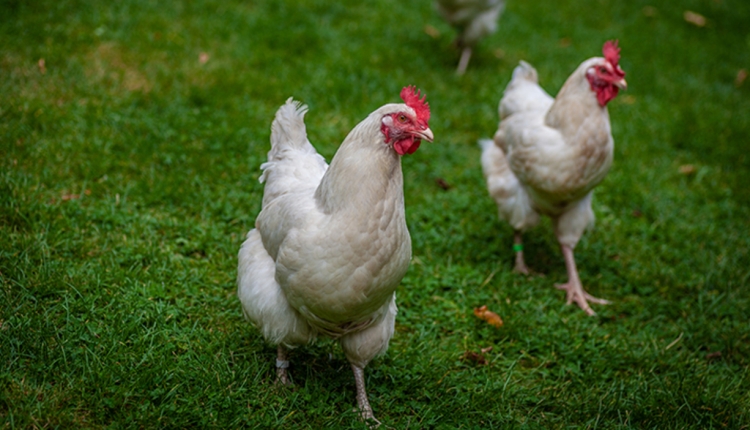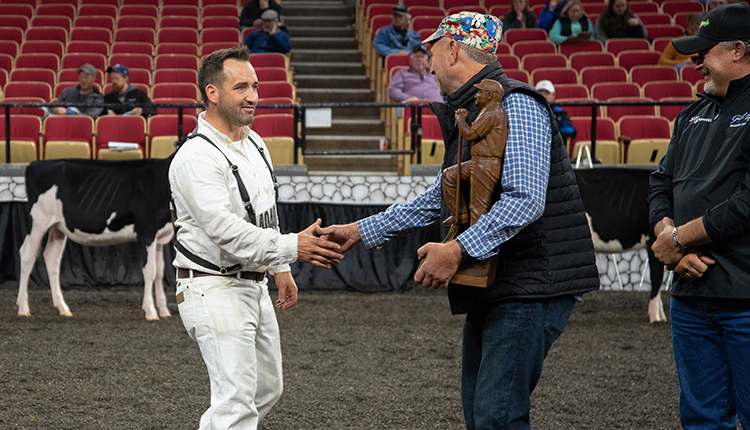In honoring herds milking 50 cows all the way to those with several thousand, the Innovation Center for U.S. Dairy formally recognized the dairy industry's wide range of efforts on the April 23 ceremony in Washington, D.C. Meanwhile, one day later at the White House, the USDA and Innovation Center for U.S. Dairy signed an accord with the mutual goal of reducing dairy's greenhouse gas emissions by 25 percent by 2020.
Before discussing the present, let's talk about the future. On April 24, an agreement was signed at the White House between USDA, represented by Secretary Vilsack, and the dairy industry, represented by Tom Gallagher from the Innovation Center for U.S. Dairy. A major focus to reduce greenhouse gas emissions will involve anaerobic digesters.
Presently, AgStar estimates that 192 anaerobic digesters are operating on commercial livestock farms in the U.S. as of September 2012. Of those, 178 generate electrical or thermal energy from the captured biogas. The 178 digesters produce about 586,000 megawatt-hours (MWh) of electricity and 55,000 MWh of other energy annually. A majority of the digesters are found on dairy farms (158 or 89 percent), followed by swine (23), poultry (4), beef (2) and mixed (5) operations. AgStar is a joint effort between the EPA, USDA and Department of Energy that promotes the use of anaerobic digesters. The Innovation Center for U.S. Dairy estimates a $3 billion potential market for gas, electricity and other digester co-products. To learn more, visit their "Dairy Power/Biogas Capture and Transport" project website at http://on.hoards.com/ICUSD2020.
The Innovation Center for U.S. Dairy has a stated goal to have 1,300 anaerobic digesters on U.S. dairy farms by 2020, said Jerry Bingold earlier this month at the National Dairy Leaders Conference gathering. To reach that goal, some 4 million dairy cows would be involved in those projects. To read the full release by USDA, click here.
As for the present efforts . . . this marks the second year for selecting the Dairy Sustainability Awards which were announced on April 23. Not all the focus was on digesters, however. Efforts did include digesters, other green energy such as wind and geothermal, water recycling, energy saving equipment, and even composting. In all, five dairy farms were honored at the second sustainability event, with two farms receiving honorable mentions. To watch a slide show of candid photos from the awards ceremony, see below. Our thanks to Brian Mano for taking the photos from Tuesday's event.

As for the five winning farms, here is a bit more information about them. By clicking on the links, you will be able to learn a great more detail.
The 2013 U.S. Dairy Sustainability Awards Winners for Outstanding Dairy Farm Sustainability
Petersen Dairy Farm, Appleton, Wis.: When the city of Appleton, Wis., decided to build a high school less than a half mile from Petersen Dairy Farm, the Petersen family began exploring composting as a way to manage the dairy's manure and associated odors. Now compost is sold at the dairy by the 5-gallon pail or truckload, primarily to home gardeners. Visitors witness firsthand how their old newspapers are recycled as bedding for the cows or mixed with manure, composted and ultimately returned to their gardens for use as mulch and to their yards for plant food. By turning their urban location into an asset, the Petersens prove that cows can be good neighbors.
Prairieland Dairy, Firth, Neb.: A creative partnership among four families put this dairy on the path to long-term prosperity and allows employees at Prairieland Dairy to focus on their specific talents. Sustainable design is reflected in every aspect of the facilities, which were built to be efficient and low-impact while maximizing cow comfort. Automatic cooling, waste management and pest control systems are just part of the solution. Prairieland Dairy also taps into the natural power of wind, gravity, and the geothermal properties of well water to reduce the use of energy, water and equipment for savings estimated at more than $200,000.
Skyridge Farms, Sunnyside, Wash.: Dan DeGroot, owner of Skyridge Farms, cultivated an organization that optimizes performance and preserves the environment. Since 2003, DeGroot has improved lighting, added occupancy sensors and installed a programmable logic control system. The management team can automatically control lighting, fans, and soaker and flush systems. By doing so, they maintain optimum performance, reduce costs and keep the herd comfortable. This upgrade alone yields a 20 percent energy savings annually across the five freestall barns. With composting, Skyridge Farms harvests manure nutrients, provides quality bedding for the herd, and eliminates 600 truckloads annually previously used to transport manure.
The 2013 U.S. Dairy Sustainability Awards Winner for Outstanding Achievement in Energy Efficiency
Ballard Family Dairy & Cheese, Gooding, Idaho: Energy efficiency is sometimes overlooked, but at Ballard Family Dairy & Cheese, the Ballards see it as a way to reduce their overhead costs and eliminate propane use. An energy audit and a team of energy management experts helped identify four primary areas of savings, which included using solar thermal power for the hot water system, installing LED lighting, replacing vacuum pumps and adjusting the milk cooling process. The Ballards achieved their goals, saving $23,000 annually and reducing the dairy's carbon footprint by 121,500 pounds per year while decreasing its water footprint by 365,000 gallons annually.
The 2013 U.S. Dairy Sustainability Awards Winners for Outstanding Achievement in Renewable Energy
Green Valley Dairy, Krakow, Wis.: At Green Valley Dairy, the management team's "waste not" philosophy has them constantly evaluating opportunities to reclaim energy, recycle water and repurpose manure nutrients. In 2005, Green Valley Dairy set out to build on this belief. The management team determined that anaerobic digesters would help manage manure nutrients and reduce odors while decreasing the dairy's carbon footprint. Although it was one of the first digesters in Wisconsin, the benefits of this plan quickly gained public support. Today, three anaerobic digesters have the capacity to produce 1,200 kWh of "green" electricity - most of which is used on the dairy or sold to the local utility.
Before discussing the present, let's talk about the future. On April 24, an agreement was signed at the White House between USDA, represented by Secretary Vilsack, and the dairy industry, represented by Tom Gallagher from the Innovation Center for U.S. Dairy. A major focus to reduce greenhouse gas emissions will involve anaerobic digesters.
Presently, AgStar estimates that 192 anaerobic digesters are operating on commercial livestock farms in the U.S. as of September 2012. Of those, 178 generate electrical or thermal energy from the captured biogas. The 178 digesters produce about 586,000 megawatt-hours (MWh) of electricity and 55,000 MWh of other energy annually. A majority of the digesters are found on dairy farms (158 or 89 percent), followed by swine (23), poultry (4), beef (2) and mixed (5) operations. AgStar is a joint effort between the EPA, USDA and Department of Energy that promotes the use of anaerobic digesters. The Innovation Center for U.S. Dairy estimates a $3 billion potential market for gas, electricity and other digester co-products. To learn more, visit their "Dairy Power/Biogas Capture and Transport" project website at http://on.hoards.com/ICUSD2020.
The Innovation Center for U.S. Dairy has a stated goal to have 1,300 anaerobic digesters on U.S. dairy farms by 2020, said Jerry Bingold earlier this month at the National Dairy Leaders Conference gathering. To reach that goal, some 4 million dairy cows would be involved in those projects. To read the full release by USDA, click here.
As for the present efforts . . . this marks the second year for selecting the Dairy Sustainability Awards which were announced on April 23. Not all the focus was on digesters, however. Efforts did include digesters, other green energy such as wind and geothermal, water recycling, energy saving equipment, and even composting. In all, five dairy farms were honored at the second sustainability event, with two farms receiving honorable mentions. To watch a slide show of candid photos from the awards ceremony, see below. Our thanks to Brian Mano for taking the photos from Tuesday's event.

As for the five winning farms, here is a bit more information about them. By clicking on the links, you will be able to learn a great more detail.
The 2013 U.S. Dairy Sustainability Awards Winners for Outstanding Dairy Farm Sustainability
Petersen Dairy Farm, Appleton, Wis.: When the city of Appleton, Wis., decided to build a high school less than a half mile from Petersen Dairy Farm, the Petersen family began exploring composting as a way to manage the dairy's manure and associated odors. Now compost is sold at the dairy by the 5-gallon pail or truckload, primarily to home gardeners. Visitors witness firsthand how their old newspapers are recycled as bedding for the cows or mixed with manure, composted and ultimately returned to their gardens for use as mulch and to their yards for plant food. By turning their urban location into an asset, the Petersens prove that cows can be good neighbors.
Prairieland Dairy, Firth, Neb.: A creative partnership among four families put this dairy on the path to long-term prosperity and allows employees at Prairieland Dairy to focus on their specific talents. Sustainable design is reflected in every aspect of the facilities, which were built to be efficient and low-impact while maximizing cow comfort. Automatic cooling, waste management and pest control systems are just part of the solution. Prairieland Dairy also taps into the natural power of wind, gravity, and the geothermal properties of well water to reduce the use of energy, water and equipment for savings estimated at more than $200,000.
Skyridge Farms, Sunnyside, Wash.: Dan DeGroot, owner of Skyridge Farms, cultivated an organization that optimizes performance and preserves the environment. Since 2003, DeGroot has improved lighting, added occupancy sensors and installed a programmable logic control system. The management team can automatically control lighting, fans, and soaker and flush systems. By doing so, they maintain optimum performance, reduce costs and keep the herd comfortable. This upgrade alone yields a 20 percent energy savings annually across the five freestall barns. With composting, Skyridge Farms harvests manure nutrients, provides quality bedding for the herd, and eliminates 600 truckloads annually previously used to transport manure.
The 2013 U.S. Dairy Sustainability Awards Winner for Outstanding Achievement in Energy Efficiency
Ballard Family Dairy & Cheese, Gooding, Idaho: Energy efficiency is sometimes overlooked, but at Ballard Family Dairy & Cheese, the Ballards see it as a way to reduce their overhead costs and eliminate propane use. An energy audit and a team of energy management experts helped identify four primary areas of savings, which included using solar thermal power for the hot water system, installing LED lighting, replacing vacuum pumps and adjusting the milk cooling process. The Ballards achieved their goals, saving $23,000 annually and reducing the dairy's carbon footprint by 121,500 pounds per year while decreasing its water footprint by 365,000 gallons annually.
The 2013 U.S. Dairy Sustainability Awards Winners for Outstanding Achievement in Renewable Energy
Green Valley Dairy, Krakow, Wis.: At Green Valley Dairy, the management team's "waste not" philosophy has them constantly evaluating opportunities to reclaim energy, recycle water and repurpose manure nutrients. In 2005, Green Valley Dairy set out to build on this belief. The management team determined that anaerobic digesters would help manage manure nutrients and reduce odors while decreasing the dairy's carbon footprint. Although it was one of the first digesters in Wisconsin, the benefits of this plan quickly gained public support. Today, three anaerobic digesters have the capacity to produce 1,200 kWh of "green" electricity - most of which is used on the dairy or sold to the local utility.









